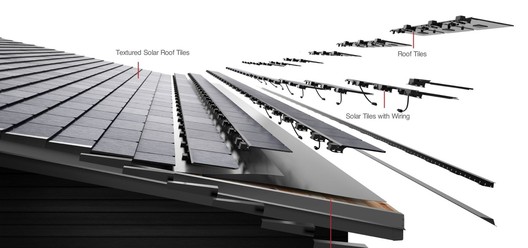Solar PV tiles, also known as solar shingles / solar slates, are simply mini solar PV panels that generate energy from the sun, designed to match your existing tiles or slates. They are government-approved and, thus, if you plan to install these instead of more conventional solar tiles, you will always demand the Feed-in Tariff.
How Do Solar Roof Tiles Work?
Their quality was influenced by the construction of older solar tiles. Solar tiles are designed to lay, without overlapping, side by side. This is vital because, instead of being shaded by other tiles, it ensures that the entire tile will produce light.
Solar PV tiles may be retrofitted, but it would include the existing roof tiles without tearing them out, so it is better to add them while building a new home.
Solar tiles work in the same manner as solar PV panels, except rather than being bolted-on, they form part of your roof. The tiles are made up of photovoltaic cells that generate an electric field that generates free energy for use within your home as sunlight shines on them.
Via electrical leads, the PV tiles are connected to a connection point in your attic. The biggest difference between solar tiles and solar panels is that, while solar panels are bolted on top of an existing roof, solar tiles are intended to function as part of the roof.
Installation Of Solar Tiles
Similar to that of roof shingles, the scale of solar shingles is similar. The solar shingles are also labor-intensive relative to the construction of solar panels. Covering a small surface with solar shingles takes a long time. One after the other, the solar shingles are arranged. The building is wired into each solar shingle element.
The time needed for solar shingles to be built depends on:
- Roof Area
- The number of workers working by the installation crew
- New roofing or current roofing conditions
Once the solar shingles are installed entirely over the roof space, a permit under the roof is applied by the installer. This is the permission for the machine to connect to the power grid.
What You Need To Know About Solar Panel And Solar Tile
You need to get acquainted with the kinds of solar panel systems that businesses typically deploy in suburban areas. You will ought to learn about the installation materials and devices used.
There are typically two key components in the full solar system kits for residences. To build direct current (DC), photovoltaic solar panels use sunlight. A solar inverter, meanwhile, transforms the electricity into an alternating current (AC) so that you can use it in your home.
Two types of solar panels are commonly available on the market: monocrystalline and polycrystalline.
Monocrystalline panels have the highest performance values and are made of uniform crystalline silicon. When they are mounted in areas that get heavy sunshine, they often last for a longer period of time and produce the best outcomes. They are, though, a little pricey as well.
Polycrystalline plates, meanwhile, are made from refined and molded silicon. They have a comparatively low heat tolerance, which in areas that have a higher temperature affects their efficiency.
There is also a reduced life cycle for these tables. But in areas which receive a smaller amount of sunshine, they perform best. That doesn’t mean, though, that they are not able to produce enough energy to fuel a home. Polycrystalline panels are much more affordable in comparison to monocrystalline panels. Solar ties have become a valuable addition to the construction and property business.
Electricity Cost & Usage Of Solar Tiles
To convert the DC electricity produced by the tiles into AC electricity, which can be used for running your appliances, you will need to mount an inverter. If a solar diverter or home battery storage device is installed, all electricity you may not use will be sent to the grid and paid for by the Feed-in Tariff.
You can see a significant reduction in your electricity bill after installing solar tiles. The solar tiles price in Pakistan varies according to the material used, but roughly the cost of solar tiles ranges from 15K to 80K.
Solar Tiles In Pakistan—New Homes Trends
An inverter that transforms the energy absorbed by each tile into electricity needs to be mounted for the successful operation of the tiles. Another option is to mount a solar diverter, or ‘domestic solar system,’ with competent oversight at all times.
The amount of energy produced by solar energy is directly proportional to the amount of sunshine the tiles are exposed to and is clearly related to the atmosphere and project location. Of course, sunny days are more energy-efficient than cloudy days,
Advantages Of Solar Roof Tiles
- For regions with high solar incidence, solar tiles are an outstanding source of renewable energy.
- Because they are part of the roof architecture and not added later, they are physically more appealing and discrete than conventional photovoltaic panels. There are several choices for solar tiles that also resemble the look of ceramic tiles or slate stone tiles, going totally unnoticed.
- They are a good choice for the restoration of buildings (when modifications are authorized) in protected areas and/or in historical areas.
Where To Install Solar Tile For Home Constructions
To the south, the safest way to face your solar panels should be. That is where the most sunshine they can get. Roofs, of course, tend to be the safest way to mount solar panels in urban areas. However, in suburban or rural areas, you can conveniently mount them on the field.
It is important to remember that a square foot will produce about 5 to 10 watts of power from a traditional solar panel. So, you’ll need at least 100 to 200 square feet of area to install the panels if you want to produce up to 1000 watts. While roof mounting is a little costlier, for places that are vulnerable to high winds or cyclones, it is not recommended.
For more information regarding home construction and property news, consult experts at Globe Estate and Builders.





